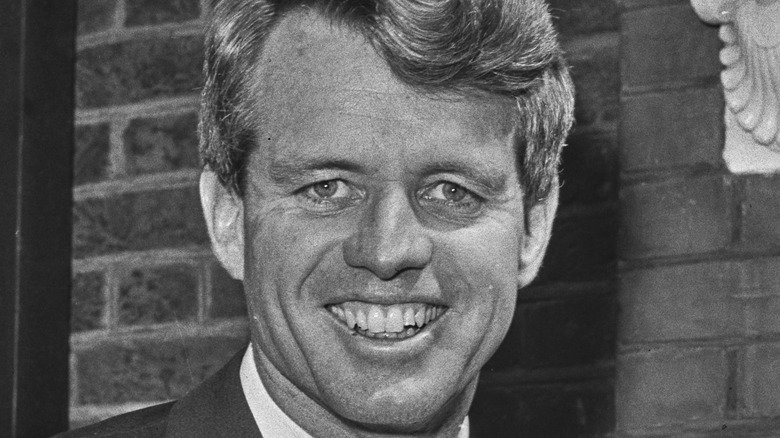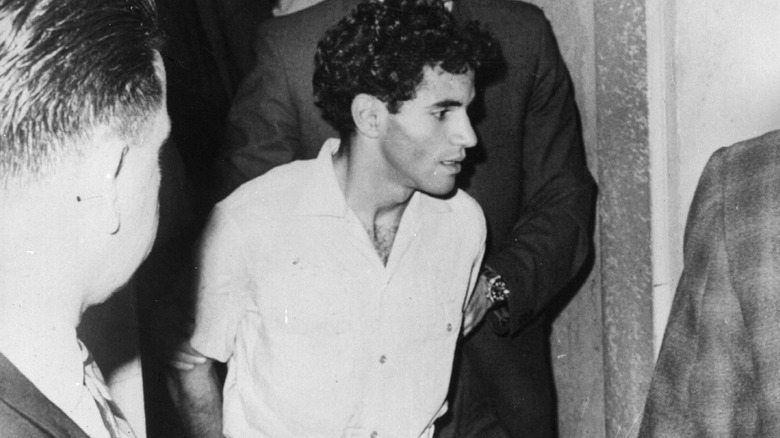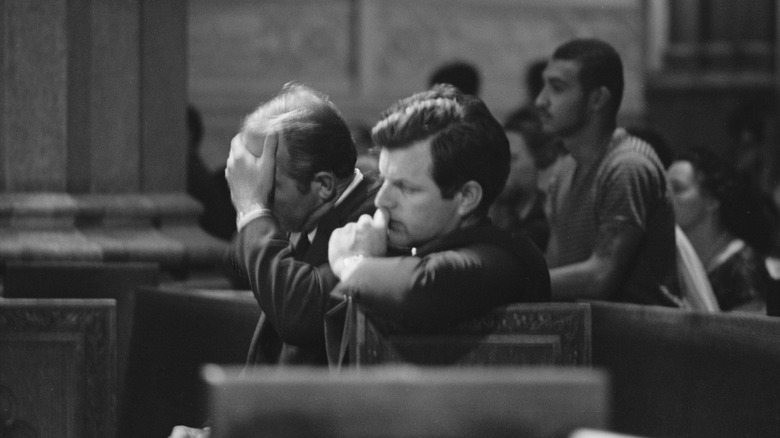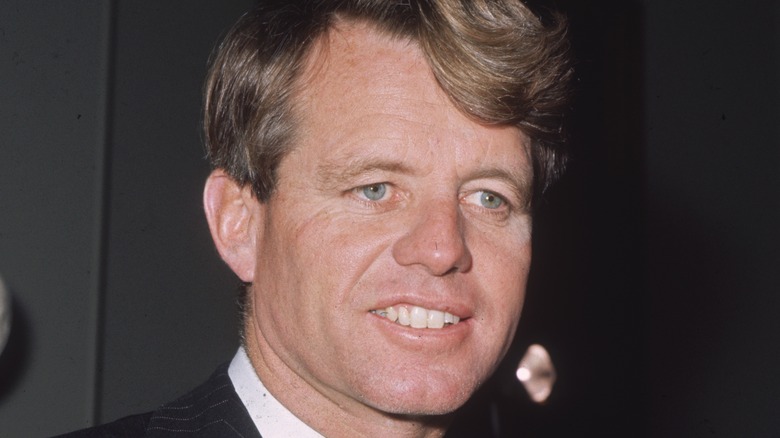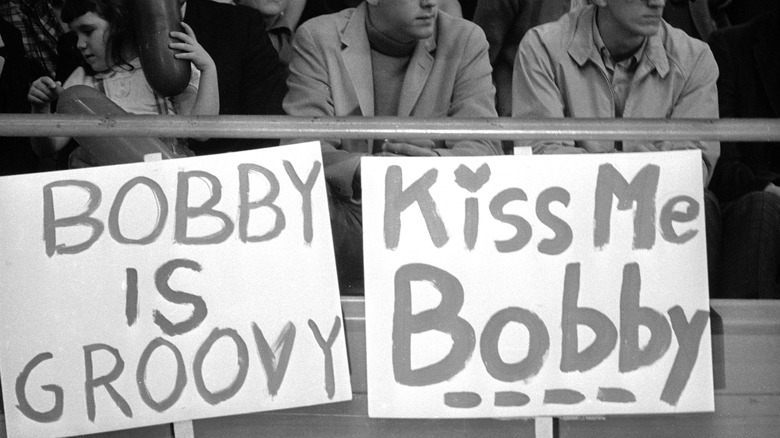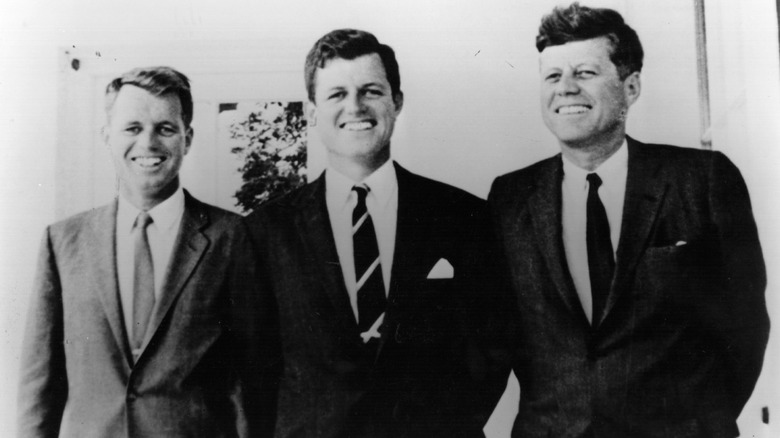Tragic Details Found In Robert F. Kennedy's Autopsy Report
In 1968, Robert F. Kennedy, a senator and former attorney general, was the frontrunner for the Democratic nomination to the presidency (via Britannica). This Kennedy, an outspoken critic of the Vietnam War and a supporter of civil rights, was seen by many as a unifying force in the left-wing of the Democratic Party in the wake of the assassination of Martin Luther King, Jr. several weeks earlier.
On June 4, Kennedy had won primaries in five out of six early states, including the delegate-rich prize of California. He gave a victory speech at Los Angeles' Ambassador Hotel and was heading back through the hotel kitchen shortly after midnight on June 5 when the Palestinian immigrant Sirhan Bishara Sirhan reportedly ambushed the senator and shot him, wounding Kennedy and five other bystanders. Kennedy died of his injuries on June 6.
Unlike the assassination of Kennedy's brother, President John F. Kennedy, several years before, there was no video of the attack. The historic records instead include a handful of photos, taken before and after Kennedy had fallen to the floor, still conscious (via Life magazine); the accounts of onlookers, including kitchen staff and Kennedy supporters; audio of the attack taken by a freelance reporter (via CNN); and Kennedy's autopsy. Here is what they reveal about the assassination, including why conspiracy theories surrounding the shooting persist to this day.
The accounts of the assassination
In eyewitness accounts of the attack, Sirhan approached Kennedy head-on and fired a couple of shots before being restrained by the crowd (via The Washington Post), some of whom managed to grab Sirhan in the chaos. Sirhan continued to shoot wildly, injuring five others in the room, before witnesses grabbed the .22-caliber Iver Johnson Cadet revolver from his hand, according to the Los Angeles Times. Rosey Grier, a former football player, and Kennedy bodyguard pinned Sirhan until the police arrived. After being shot, Kennedy, according to witnesses, immediately asked if everyone else was okay and remained at least semi-conscious in the aftermath, even as he was put on a stretcher.
Witnesses said that Sirhan never got closer than 18 inches away from the candidate, according to the Boston Globe. But an expert interviewed by the paper also points out that before shooting Kennedy, Sirhan shot a member of his entourage, Paul Schrade, whose collapse might have pushed the senator closer to the shooter. (This will become an important detail.)
Years later in a 1989 interview with Inside Edition (via YouTube), Sirhan said he shot Kennedy because he felt betrayed by the politician after he suggested during his presidential campaign that he may send 50 fighter jets to aid Israel in their fight against the Palestinians. Sirhan said his goal wasn't to harm Kennedy, who he admired as a "protector and defender of the downtrodden" but to save his people.
Mr. Kennedy ”was my hero,” Sirhan said. ”He was my champion.”
Kennedy's fight for his life
In 2018, half a century after the assassination, the Journal of Neurosurgery published a medical analysis of the medical care that Robert F. Kennedy received in the hours between his attack and his death. Five doctors, who had been in the ballroom where Kennedy had given his victory speech, were called to the senator's side. One physician noted that his heartbeat had slowed to 50 to 60 beats per minute, and that his left eye was closed. Despite this condition, Kennedy was still able to move his limbs.
As the senator slowly slipped into unconsciousness, another doctor noted that his blood was clotting around the bullet hole in his head. Assuming that the clot was causing blood to pool in his brain, the doctor slipped his finger into the wound, resuming the blood flow and returning Kennedy to consciousness.
Meanwhile, the hotel's switchboard operator called 911 and told the dispatcher that Kennedy had been injured, but the emergency responder did not know the extent of the injuries and directed the ambulance to a smaller facility, the Central Receiving Hospital, instead of the larger and better-equipped Good Samaritan Hospital.
"Please don't lift me"
The last words of Robert F. Kennedy may have been "Please don't lift me!" as he was put on a stretcher, UPI reported. By the time Kennedy arrived at the hospital, he was unconscious and not breathing, according to the Journal of Neurosurgery. The doctors at Central Receiving stabilized Kennedy and restored his breathing, but soon realized he needed treatment at Good Samaritan Hospital instead. The mistake meant that Kennedy did not arrive at the better-equipped hospital until 1 a.m., about 45 minutes after the shooting.
He was immediately given a tracheostomy followed by a whole blood transplant and was scheduled for a craniotomy — brain surgery — which he entered at 3:10 a.m. Over nearly the next four hours, surgeons removed as many bone and bullet fragments as they could while controlling the bleeding. Though this resulted in improved motor response to pain, his left side remained paralyzed.
It became clear that in the unlikely event that Kennedy survived, the damage to his brain would be extensive. Though Kennedy remained in stable condition through much of June 5, by 6 p.m. that day, his vitals began to slip. He was pronounced dead at 1:44 a.m. on June 6. The presidential hopeful left behind a pregnant wife and 10 children, according to Newsweek.
The autopsy and its contradictions
The autopsy was conducted by Los Angeles County Chief Medical Examiner Thomas Noguchi (via Journal of Neurosurgery). In his lengthy career, Noguchi would perform autopsies on Marilyn Monroe, Sharon Tate, Natalie Wood, Janice Joplin, and John Belushi, among others. Noguchi was also sometimes criticized for his dishy comments about said celebrities to the media (via The New York Times) — and while Kennedy was in the hospital, he reportedly danced with joy, according to UPI (via California Digital Newspaper Collection), saying "I am going to be famous. I hope he dies." That said, The Journal of Neurosurgery notes that Noguchi's autopsy of Kennedy has a stellar reputation — it's been dubbed, in fact, "the perfect autopsy."
The autopsy revealed that three bullets wounded the senator. The first bullet entered behind his right ear — this would end up being the fatal shot, and Noguchi determined it had been fired within three inches of the head due to the presence of gunpowder burns on the skin. Two other bullets entered Kenndy's right shoulder region, also from behind. These injuries, however, were comparatively minor.
Conspiracies and explanations
Interestingly, Kennedy's autopsy contradicted the reports of witnesses in a number of ways and is the primary source of many ongoing conspiracy theories about the assassination. All three shots were from behind Kennedy, and the fatal shot was fired with the muzzle of the gun nearly touching Kennedy's head. Since Sirhan Sirhan approached Kennedy head-on and was reportedly stopped more than a foot away from Kennedy, this has sometimes been seen as the strongest evidence that there was a second shooter that day, as some witnesses have claimed.
There is, however, a simpler explanation for why the shots came from behind Kennedy. Before the shooting, the senator had turned to his left to shake a bus boy's hand. When Sirhan Sirhan lunged at Kennedy, he may have ducked further in self-defense, exposing his back to the assassin. "The conspiracy people will have you believe that Kennedy is standing there, putting his chest out," said the journalist Dan Moldea, who wrote a book on the assassination, to The Boston Globe. "If you see someone running at you, shouting 'You son of a b****,' he's got a gun in his hand, what are you going to do? You're going to turn defensively."
